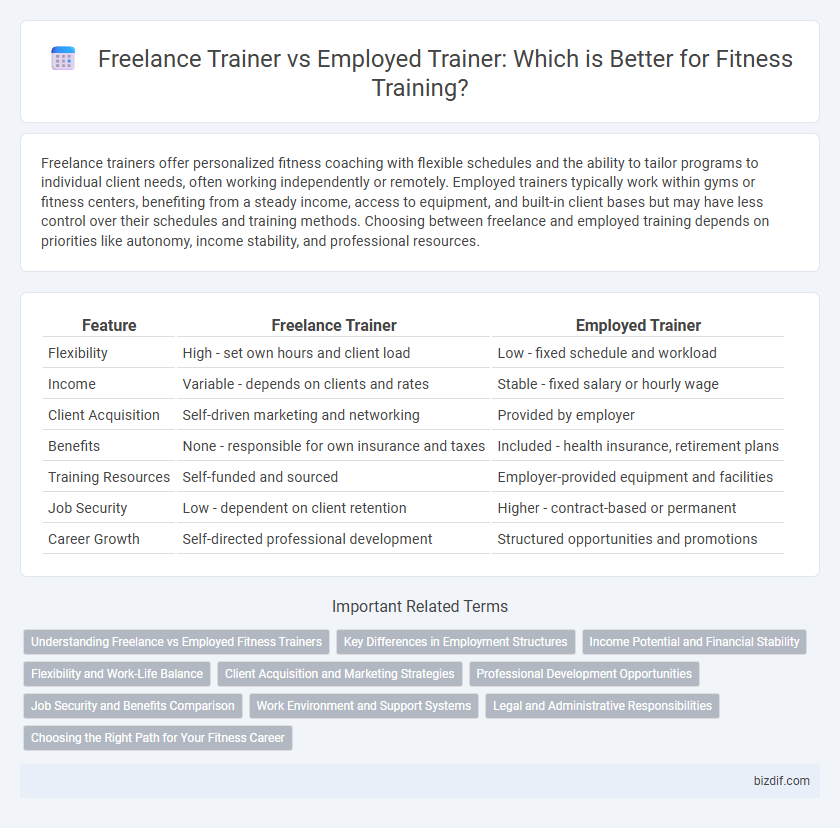Freelance trainers offer personalized fitness coaching with flexible schedules and the ability to tailor programs to individual client needs, often working independently or remotely. Employed trainers typically work within gyms or fitness centers, benefiting from a steady income, access to equipment, and built-in client bases but may have less control over their schedules and training methods. Choosing between freelance and employed training depends on priorities like autonomy, income stability, and professional resources.
Table of Comparison
| Feature | Freelance Trainer | Employed Trainer |
|---|---|---|
| Flexibility | High - set own hours and client load | Low - fixed schedule and workload |
| Income | Variable - depends on clients and rates | Stable - fixed salary or hourly wage |
| Client Acquisition | Self-driven marketing and networking | Provided by employer |
| Benefits | None - responsible for own insurance and taxes | Included - health insurance, retirement plans |
| Training Resources | Self-funded and sourced | Employer-provided equipment and facilities |
| Job Security | Low - dependent on client retention | Higher - contract-based or permanent |
| Career Growth | Self-directed professional development | Structured opportunities and promotions |
Understanding Freelance vs Employed Fitness Trainers
Freelance fitness trainers offer flexible scheduling and personalized training services, often setting their own rates and managing their client base independently. Employed trainers typically work at gyms or fitness centers with a fixed salary, consistent hours, and access to on-site equipment and facilities. Understanding these differences helps clients choose based on their needs for flexibility, cost, and access to resources.
Key Differences in Employment Structures
Freelance trainers operate as independent contractors, managing their own schedules, client lists, and taxes, which allows for greater flexibility but less job security and benefits. Employed trainers work under a fitness facility or company, receiving a fixed salary or hourly wage, with access to employee benefits such as health insurance, paid leave, and structured career progression. These distinct employment structures influence income stability, administrative responsibilities, and professional development opportunities within the fitness industry.
Income Potential and Financial Stability
Freelance trainers often experience higher income potential through flexible client pricing and diverse revenue streams such as online coaching and workshops. Employed trainers enjoy financial stability with consistent salaries, benefits, and predictable hours, reducing income volatility. Balancing freelance income variability against employment stability depends on individual risk tolerance and career goals in the fitness industry.
Flexibility and Work-Life Balance
Freelance trainers benefit from high flexibility in scheduling, enabling better work-life balance by choosing clients and workout times based on personal preferences. Employed trainers often follow fixed shifts and assigned locations, which may limit adaptability but provide stable income and structured hours. Balancing client demands with personal time is generally easier for freelance trainers due to their control over workload and remote training possibilities.
Client Acquisition and Marketing Strategies
Freelance trainers often rely heavily on digital marketing, social media, and personal branding to attract and retain clients, leveraging platforms like Instagram, TikTok, and fitness apps to showcase expertise and gather testimonials. Employed trainers benefit from the gym or organization's built-in client base and marketing resources, enabling a more consistent flow of clients with less direct personal promotion. Freelancers face the challenge of building trust and visibility independently, whereas employed trainers gain exposure through structured marketing strategies and established networks.
Professional Development Opportunities
Freelance trainers often access diverse professional development opportunities by working with varied clients and industry sectors, enhancing adaptability and specialized skills. Employed trainers typically benefit from structured training programs, certifications, and career advancement within a single organization providing consistent support. Both pathways offer distinct growth potentials shaped by individual career goals and the preferred learning environment.
Job Security and Benefits Comparison
Freelance trainers often face fluctuating income streams and lack guaranteed job security compared to employed trainers who receive consistent salaries and employer-backed benefits such as health insurance and retirement plans. Employed trainers typically have access to paid leave, professional development opportunities, and workplace resources, enhancing overall job stability. Freelancers gain flexibility and autonomy but must independently manage taxes, insurance, and client acquisition, impacting long-term financial security.
Work Environment and Support Systems
Freelance trainers often enjoy flexible work environments but face limited access to structured support systems such as administrative assistance, equipment, and client referrals. Employed trainers benefit from a stable workplace, consistent access to facilities, and professional support staff that enhance client management and marketing efforts. The choice between freelance and employed roles significantly impacts daily operations and career development opportunities in fitness training.
Legal and Administrative Responsibilities
Freelance trainers manage their own contracts, tax filings, and insurance, requiring strong organizational skills to comply with legal obligations. Employed trainers benefit from their employer handling payroll taxes, workers' compensation, and liability coverage, reducing administrative burdens. Understanding these distinctions helps fitness professionals choose the best path aligned with their capacity for legal and financial management.
Choosing the Right Path for Your Fitness Career
Freelance trainers enjoy flexibility and control over their schedules, allowing them to build personalized client relationships and diversify income streams through various fitness modalities. Employed trainers benefit from job stability, consistent income, and access to gym resources, which can enhance professional development and client trust. Selecting the right path depends on prioritizing autonomy and entrepreneurial growth versus stability and structured support within the fitness industry.
Freelance Trainer vs Employed Trainer Infographic

 bizdif.com
bizdif.com